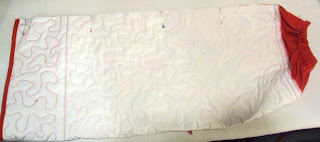My husband is always throwing away all my spare grocery bags because they are in disarray in my pantry. I need those for dirty diapers! I finally got around to making this cute dispenser bag and thought I'd share it with you...
1 fat quarter (18" x 22") print
1/4 yard coordinating solid
2 - 1" x 20" strips interfacing
22" x 29" batting
22" x 29" muslin for backing
11" of 3/4" wide elastic
2 - 1/4" eyelets
Directions
1. Cut the print fat quarter down to 18" x 20". Save the leftover strip for the bag's handle.
2. Cut the coordinating solid into the following sizes:
2 - 5" x 20" rectangles
1 - 2 1/2" x 20" strip (for binding the top)
3. Sew one 5" x 20" rectangle to the top of the 18" x 20" print and one to the bottom using a 1/4" seam allowance.
4. Before sewing the decorative stitching on the red solid, we will add interfacing to give the material extra support. Pin the 1" x 20" strip interfacing to the wrong side of the red solid along the seam you sewed in step 3. Do this at both the top and bottom seams.
5. Sew a decorative stitch about a 1/4" from the seam on top of the interfacing. Use the seam as your guide. I chose a little leafy stitch to pick up the leaves in the apples. Sew decorative stitching at both the top and bottom seam on the red solid.
6. Now make your quilt sandwich. Muslin backing on the bottom, then batting, and quilt top on top, making sure to center the quilt top over the larger layers underneath. Baste with pins.
7. Now it's time to quilt.
Important! Only quilt the top red solid and the print portion of your quilt. Leave the bottom red portion unquilted. It will be much easier to make the casing for the elastic and gather it all up if the bottom is left unquilted. In addition to stippling an all over pattern on the top two portions of the quilt, I also stitched-in-the-ditch using a walking foot at the seam where the print meets the bottom portion of the red solid.
8. Trim the excess batting and muslin from all sides of your quilt.
9. Trim with scissors the unquilted batting and muslin from the bottom portion of the quilt to reduce bulk.
10. The top of the quilt is finished with binding. The bottom has elastic casing to keep the grocery bags in. The next step is to make the binding. Using the 2 1/2" x 20" strip of red solid cut in the beginning, fold it in half widthwise, wrong sides together. Place the raw edges of your folded strip against the raw edges of the top of the quilt and sew across the entire length of the strip, 1/4" from the edge.
11. Fold the binding strip over and sew the entire length of the strip to the back of the quilt, using a top stitch (about 1/8" from the edge) to secure the binding.
Here's what the binding looks like from the front.
12. Now we turn our attention to the bottom of the quilt to make the casing for the elastic. Fold the bottom edge under 1/4" and press.
13. Fold again, this time 3/4" to create the casing for the elastic. Slip your elastic strip in there just to make sure it fits. Press.
14. Stitch a topstitch (about 1/8") from the edge of the casing along the entire width of the quilt.
15. Use a safety pin, threaded through the end of your elastic to feed the elastic through the casing. Make sure to hold on to the other end of the elastic so it doesn't disappear into the middle of your casing sleeve!
16. Fold the quilt in half with right sides together. Match the seams where the red solid meets the print and pin in place. Also make sure to match the elastic and casing sleeve. Then sew along the length of the open edge to create a cylinder with one gathered end.
Turn it right side out, and it looks like this!
17. Next we'll make the handle. Grab the leftover strip of print you cut off earlier. It should be about 2" x 18". To have finished looking ends on the handle, fold under (wrong sides together) about 1/4" on each short edge and press.
18. Fold the strip in half widthwise, right sides together. Then sew along the entire length of the strip about 1/8" from the edge. Turn the strip right sides out.
19. Using a pen, mark the desired location for the eyelet hole. I placed my eyelets about 1/2" down from the binding. If you are looking at your cylinder from the top (with the gather at the bottom), place the lengthwise seam at 12 o'clock or at the back. The front of your bag, the part you'll see is now at 6 o'clock. Ideally, you should place the eyelets at 3 o'clock and 9 o'clock.
20. Follow the manufacturer's instructions for the eyelet press to install the eyelets at the locations you have marked. Thread the handle through the eyelet and tie a simple knot on the end.
Done! And now you have a beautiful way to store these bags for recycling!





























